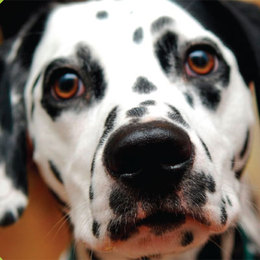
The role of animals in our lives ranges from companion to work-horse to demanding diva—and now physical therapist. There’s no disputing the healing powers of an emotional bond with an animal, and many area pets are involved in special animal therapy programs that facilitate animal visits to hospitals, nursing homes and hospice centers.
At Bryn Mawr Rehab Hospital, animals are assisting patients not only in an emotional way, but also in a physical way. Samantha Weber, a clinical mentor at Bryn Mawr Rehab, says that the dogs involved in the animal-assisted therapy program help to motivate the patients. “The dogs provide more incentive so the patients forget that they are doing therapy,” she says.
Bryn Mawr Volunteer Coordinator Yvonne Navarro-Brewer agrees that including animals in the physical therapy activities can help to break up typically repetitive tasks in a way that interests the patients.
Animal-assisted therapy comes in a variety of forms, Weber explains. Walking with a dog is a helpful exercise for patients with balance issues. Playing fetch can be used to improve hand-eye coordination for some patients. Others may simply pet a dog to encourage them to use their hands and arms.
The therapy also has subtler effects. Weber says it helps bring normalcy to patients struggling with changed lives.
“It is a positive and normal activity, something a dog-lover would do even they if they weren’t in the hospital,” she says. Weber has seen patients smile for the first time without realizing it, and for some, that alone is an important goal.
The president and founder of the Wayne-based organization Pals For Life, Paula Kielich, says that in addition to physical therapy, her 150 volunteers also visit nursing homes, hospitals and schools.
According to Kielich, nursing home patients are often very moved by the experience, as many once had pets of their own and enjoy sharing their memories. Kielich recalls an emotional moment when a Belgian Shepherd named Tina insisted entering a darkened room during one visit. When the woman in the room saw Tina next to her, she put her arms around the dog and began to sob. The woman later explained she had just learned that her sister passed away, and she told Kielich that an angel must have sent Tina to comfort her.
To be in the program, a dog needs only to like people and enjoy affection, Kielich says. “We have breeds of all sizes from a teacup Chihuahua to Mastiff.” Pals For Life membership is not limited to dog owners, either— cats, rabbits, turtles and guinea pigs are among the pets brought to therapy visits.
The therapy dogs at Bryn Mawr Rehab must earn training certifications and pass an American Kennel Club “Canine Good Citizen” test. The human volunteers at Bryn Mawr Rehab must receive basic health care training and testing.
Jim Knisley was once a patient at Bryn Mawr Rehab Hospital and decided to volunteer with the animal-assisted therapy program as an extension of his continuing rehabilitation. He and his dog, Emme, attended training and now volunteer through a group in Pottstown. He says he enjoys visiting with patients and seeing how they benefit from the affection and encouragement Emme provides. When it comes to recovery, Knisley says, “it’s all about a good attitude.”
Get Involved
Bryn Mawr Rehab Hospital
volunteer office: 484-596-5599
Pals For Life
610-687-1101, PalsForLife.org
The Children's Hospital of Philadelphia,
215-590-2001, childlife@email.chop.edu
Thorncroft Equestrian Center for therapeutic riding
190 Line Road, Malvern, 610-644-1963,
ThorncroftEquestrianCenter.org
Lankenau Hospital
volunteer office: 484-476-2138
Paoli Hospital
volunteer office: 484-565-1099
ComfortCaringCanines.org
ccc@comfortcaringcanines.org
Get Certified:
American Kennel Club www.akc.org
(Canine Good Citizen Program)
Delta Society www.deltasociety.org
Therapy Dogs International www.tdidog.org


